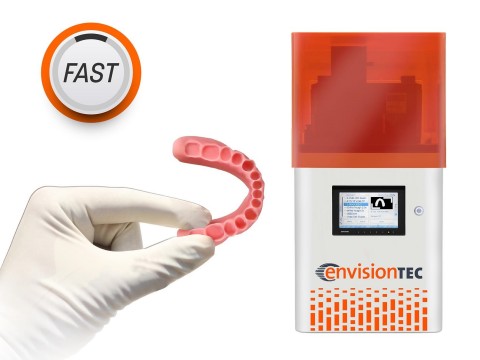 Register to receive a free U.S. Market Report Suite for Digital Dentistry Devices report synopsis and brochure
Register to receive a free U.S. Market Report Suite for Digital Dentistry Devices report synopsis and brochure
EnvisionTEC, the global leader in high-accuracy dental 3D printers and materials, revealed its largest printer ever based on its patented continuous 3D printing technology.
The new Vida cDLM was on display at LMT Lab Day Chicago 2018, where dental lab owners, managers, technicians and clinicians from more than 40 countries gathered to look at the latest technology for dental manufacturing.
With a print speed of about 20-50 mm per hour, depending on material, the Vida cDLM prints models in about half the time as the company’s best-selling Vida desktop 3D printer.
The high-speed Vida cDLM features an impressive build area of 145 x 81.5 x 100 mm (5.7 x 3.2 x 3.94 inches) and XY resolution of 76 microns. When paired with EnvisionTEC’s premium E-Model Light material, the Vida cDLM can 3D print:
- 10-12 vertical orthodontic models in 100 micron layers in about 90 minutes
- 3-4 horizontal orthodontic models in 100 micron layers in about 15-30 minutes
- 3-4 full crown and bridge arches in 50 micron layers in about an hour
What’s more, the Vida cDLM is capable of 3D printing night guards and bite splints in about 15-20 minutes using EnvisionTEC’s FDA-approved E-Guard material. When processing the company’s FDA-approved E-Denture material, the Vida cDLM can print six denture bases in 80 minutes, at a speed of 47 mm per hour.
Continuous 3D Printing Breakthrough
Continuous 3D printing technology is the next evolution of Digital Light Processing, or DLP, a process that EnvisionTEC commercialized in 2002 that uses a high-definition projector to cure photosensitive resin.
In 2006, EnvisionTEC filed for a patent on continuous 3D printing that for allows nonstop motion of the build platform in the Z axis, resulting in high-speed 3D printing with fewer supports, among other benefits. The patent was granted in 2011.
However, EnvisionTEC recognized that continuous 3D printing had challenges in delivering accurate parts consistently across larger build areas. Using oxygen to create a dead zone on which to print continuously can cause the material tray to tent slightly from the pressure of the oxygen. This can cause grave inaccuracies in the Z axis that can compromise dental products.
EnvisionTEC’s patent-pending domeless material tray remains flat and parallel during continuous printing — ensuring consistent accuracy across the entire build area.
A Growing Family of Benefits
The Vida cDLM joins EnvisionTEC’s growing family of continuous 3D printers, which serves a variety of industries. The lineup now includes:
- Vida cDLM, with XY resolution of 76 microns and a build area of 145 x 81.5 x 100 mm (5.7 x 3.2 x 3.94 in.)
- Vida HD cDLM, with XY resolution of 50 microns and a build area of 90 x 50 x 100 mm (3.54 x 1.97 x 3.94 in.)
- Vida UHD cDLM, with XY resolution of 33 microns and a build area of 63.3 x 35.6 x 100 mm (2.5 x 1.4 x 3.94 in.)
- Micro cDLM, with XY resolution of 39.8 microns and a build area of 45 x 28 x 75 mm (1.8 x 1.1 x 2.95 in.)
Aside from high speeds, continuous 3D printing also offers other benefits. In the jewelry sector, for example, cDLM technology enables 3D printing of materials with an extremely high wax content, which is desirable for investment casting patterns. The cDLM can also process dual-cure engineering-grade materials with a short pot life – materials that can deliver properties similar to injection molded plastics.
DEARBORN, Mich.–(BUSINESS WIRE)–https://www.businesswire.com/news/home/20180222006310/en/
For Further Information
More on the digital dentistry device market in the U.S. can be found in a series of reports published by iData entitled the U.S. Market Report Suite for Digital Dentistry Devices. The full report suite on the U.S. market for digital dentistry includes CAD/CAM systems, CAD/CAM materials and rapid prototyping systems. There is also an analysis provided on CAD/CAM software within the laboratory environment.
The iData series on the market for digital dentistry devices covers the U.S., Japan, South Korea, Australia, China, India, Argentina, Mexico, Brazil and 15 countries in Europe including Germany, France, the United Kingdom (U.K.), Italy, Spain, Benelux (Belgium, Netherlands and Luxembourg), Scandinavia (Finland, Denmark, Sweden and Norway), Portugal, Austria and Switzerland. Reports provide a comprehensive analysis including units sold, procedure numbers, market value, forecasts, as well as detailed competitive market shares and analysis of major players’ success strategies in each market and segment. To find out more about digital dentistry device market data, register online or email us at info@idataresearch.net for a U.S. Market Report Suite for Digital Dentistry Devices brochure and synopsis.
 Register to receive a free
Register to receive a free